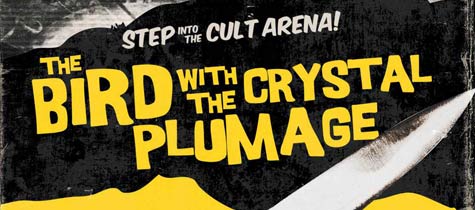
The term giallo gets thrown around a lot by people talking about certain films. Sometimes I wonder how diverse are the definitions of the genre held by those of us who use the word. I’m sure the description giallo film could be stretched to include a lot of different things, but for me it means a kind of movie that comes from Italy and that began in the 1960s but enjoyed its heyday in the early-to-mid ‘70s. These gialli generally include some combination of the following elements: Hitchcockian suspense, slasher film gore, softcore sexuality, beautiful people wearing chic European clothing, and an overall feel of daring experimentation. And there’s usually out-there music, sometimes composed by Ennio Morricone who is mostly known for his spaghetti Western soundtracks but who did so much more. So I say a giallo film is a stylized Italian crime/suspense/softcore movie with a cool soundtrack. If you disagree, well, say so.
One of the most celebrated purveyors of giallo cinema is Italian auteur Dario Argento. I’d love to read (maybe even write?) a Criminal Element Hall-of-Famer article that offers a critical overview of Argento’s entire filmmaking career. But for now I’m going to focus on his debut feature: the 1970 giallo classic The Bird with the Crystal Plumage. The movie’s script was written by Argento himself, was nominated for Mystery Writers of America’s Edgar Award, and is generally considered to be a loose adaptation of Fredric Brown’s 1949 novel The Screaming Mimi, although Argento never credited Brown as such. There are several characters involved in the tale but the two main roles are played by Tony Musante and Suzy Kendall. Musante was perhaps best known for playing the title role of the short-lived 70s cop show Toma, which was the predecessor of Baretta. Kendall, one-time spouse of Dudley Moore, starred in other notable giallo titles, as well as the classic social films Up the Junction (1968) and To Sir, with Love (1967).
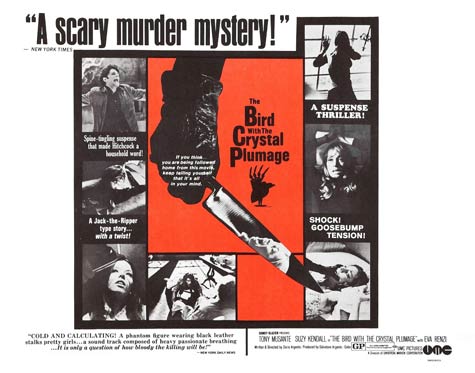
The story is thus: Musante is Sam Dalmas, an American writer who’s been living in Rome for the past few years. He went to Europe hoping to find literary inspiration there, but he’s been in a creative funk his entire time abroad and he’s finally ready to go back home to the States. Just a few days before he’s due to catch his flight back to America, though, he is witness to a bizarre scene: out on an evening stroll, he passes by an art gallery and sees, through a glass door, a woman in a struggle with a shadowy figure who stabs her. Dalmas’s presence causes the lady’s nemesis to flee and she survives with only flesh wounds.
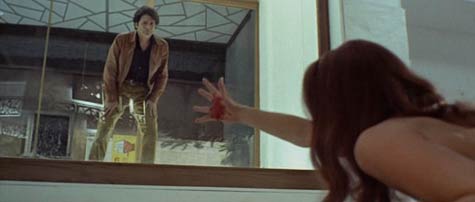
Dalmas is ready to just go back home shaking his head at this strange and disturbing incident, but the Italian police prefer that he stick around. You see, there’s been a series of killings of young, pretty women (such as the lady whom Dalmas sees assaulted) in the city and the cops believe the same assailant is behind all of these murders; furthermore, they suspect that the man who was after the woman at the gallery may be their guy. Since Dalmas caught a glimpse of the fellow, albeit a cursory one, they view him as an important witness and they don’t want him getting scarce until the killer is nailed. The Inspector confiscates his passport and he is forced to cancel his flight reservation.
Initially, Dalmas in pissed that he’s being forced to remain in Italy. But as the days go on and as he undertakes his own investigation into the spree of killings, he becomes obsessed with figuring out the identity of the fleeting figure from the attack scene he witnessed. When he starts to get threatening phone calls and when he comes under physical attack himself, it becomes a personal matter. Also, from the get-go, he feels that there was something off about the struggle he saw between the woman and the assailant, something about the scene that he can’t quite put his finger on, but that suggests there was something more at play than what met his bewildered eyes; and he wants to know what that something is. Dalmas’s girlfriend, a model played by Kendall, initially finds humor in his predicament then feels indignant on his behalf for the way the police force him to aid in their investigation. But she, too, comes to be fascinated by the mystery and she assists Dalmas in his explorations.
Whether or not Argento owed Brown an apology and some cash for supplying the inspiration for the story behind The Bird with the Crystal Plumage, it is a brilliant film and a startlingly strong first directorial effort. And in my mind it is one of the best examples of a well-made giallo film. The goosebump-inducing suspense is palpable throughout. There’s some knife and blood play that will titillate gore-hounds, yet that element never becomes gratuitous. There are no explicit sex scenes, but there’s plenty of slap and tickle between the hunky Musante and the ridiculously beautiful Kendall, and the supercharged chemistry between them adds an erotic undertone to the entire film.
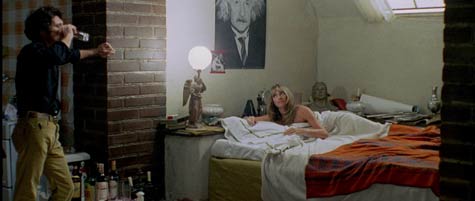
There’s a slew of enjoyably eccentric side characters. And, even amid all the fright and all the tension, Argento manages to work in some highly effective dark humor. Morricone’s soundtrack music is fittingly eerie.
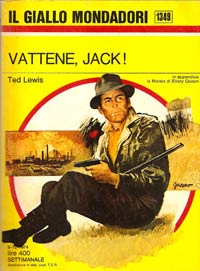
As for film, Argento was just beginning what has been a celebrated filmmaking career. He’s made enough landmark movies that if you asked 10 of his ardent fans for their favorite Argento title, you might get 10 different responses. But his very first movie is still the one that has the strongest hold over me.
Brian Greene's short stories, personal essays, and writings on books, music, and film have appeared in more than 20 different publications since 2008. His articles on crime fiction have also been published by Crime Time, Paperback Parade, Noir Originals, and Mulholland Books. Brian lives in Durham, NC with his wife Abby, their daughters Violet and Melody, their cat Rita Lee, and too many books. Follow Brian on Twitter @brianjoebrain.

You gave me an education this time, Brian. I knew nothing of this film though I am a fan of Fredric Brown’s work upon which it is based. I checked and its available on Amazon Prime (where I watch a lot of my films) but at 9.99 will wait until its free. PS Like you wanted to know any of that. 🙂
I’m happy to give back a little, David. I’ve learned so much from your posts here. I look forward to more from you.
I will be checking this out, too. I never even heard of it before.
I hope you enjoy it, Teddy. Let me know what you think once you’ve seen it.
Good piece, Brian. I have to come clean and say I’m one of those VERY ardent Argento fans, someone who’s watched everything he’s made, great and not great, and probably gotten on friends’ nerves talking their ears off about the man and his films. As you say, this was a strong debut film, but from the Maestro there was so much more to come,
Thanks, Scott. And here’s my vote for you to do a Hall of Famer piece on Argento. I’d love to read that.
Thanks, Brian. It would be a lot of fun to do. Think you’ve convinced me. Cheers!